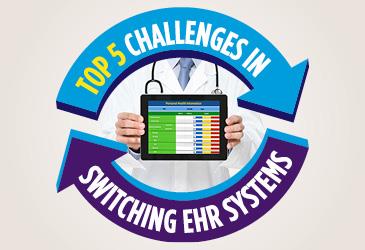Electronic health record (EHR) systems are part of the fabric of medical practice in the 21st century, but many of today’s systems are far from perfect. Find out why physicians are changing from one EHR to another, and the challenges they encounter in doing so.
A survey published in the January issue of Family Practice Magazine examined physicians’ experiences with changing EHRs in the past five years. The magazine’s medical editor, Kenneth Adler, MD, presented the findings last month at a session during the 2015 annual meeting of the Healthcare Information and Management Systems Society in Chicago.
Why physicians change EHRs
The top reasons given for switching EHR systems were:
- Gain added functionality
- Achieve meaningful use
- Get better usability
- Find better support and training
- Consolidate multiple EHRs
Challenges to change
About 80 percent of respondents said the biggest challenge in changing EHRs was the time investment required, and 70 percent pointed to productivity loss as the biggest challenge. Many also said they found it challenging to learn how to use a new EHR and that the cost of the switch was burdensome.
How the change is working now
About 60 percent of respondents said their new EHR has useful functionality, and around 55 percent said their new EHR has allowed them to achieve meaningful use.
The responses not surprisingly also showed that changing EHRs is a major undertaking, expensive and time-consuming.
But did making the switch improve their productivity? Almost one-half said no, and about one-quarter said yes. The remaining one-quarter were neutral.
“Although changing an EHR does add useful functionality and helps achieve meaningful use,” Dr. Adler said. “[It] does not make physicians happier or lead consistently to better overall EHR performance.”
Of the 305 family physician respondents to the survey, about one-half worked in hospital- or health system-owned practices. About 41 percent worked in physician-owned practices. Roughly one-quarter worked in practices with 100 or more physicians, while 21 percent were in solo practice.
The AMA is working to improve EHRs through its Physician Satisfaction and Practice Sustainability initiative, ensuring the voices of physicians are part of EHR development.
Last year, the AMA released a blueprint outlining ways to improve the Medicare and Medicaid meaningful use program and a framework that details eight priorities for moving toward more usable EHR systems. The AMA is using this framework to work with physicians, vendors, policymakers, health care systems and researchers to drive EHR improvements that can advance the delivery of high-quality, affordable care.
Tell us: Have you changed EHRs in the past five years? What was your experience like? Tell us in a comment below.




